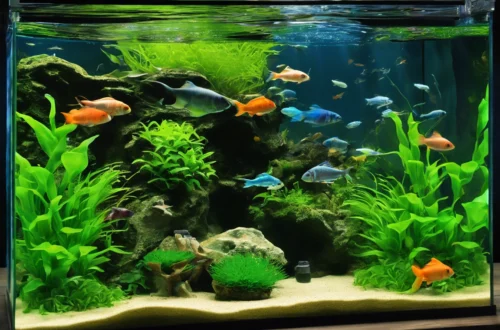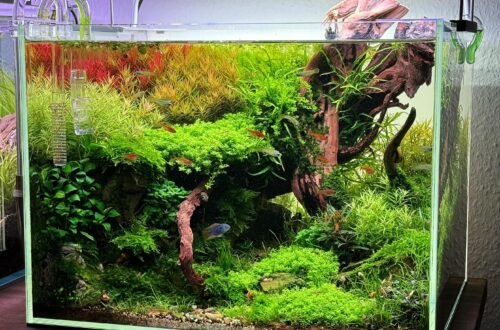Decorating your aquarium is one of the most fun and creative parts of setting up a fish tank. I’ve spent countless hours arranging (and rearranging!) driftwood and rocks in my tanks, and it’s always satisfying when you get that perfect layout that both looks great and keeps your fish happy. Driftwood and rocks are not just for aesthetic purposes—they provide hiding spots, create natural territories, and can even affect the water chemistry in your tank. If you’re diving into aquascaping with driftwood and rocks, let me share some tips and tricks I’ve picked up along the way to help you get started!
Choosing the Right Driftwood for Your Aquarium
When I first started using driftwood, I was overwhelmed by the options—Mopani, Malaysian, Spider wood, you name it. The key is to pick driftwood that suits your tank’s style and the needs of your fish. My personal favorite has been Mopani wood; its dark, smooth look contrasts beautifully with green plants. However, it can leach tannins into the water, which turns it a tea-like color. While this isn’t harmful (and can actually be beneficial for some fish), it’s something to keep in mind if you want crystal-clear water.
Preparing Driftwood for Your Tank
Before adding driftwood to your aquarium, it’s crucial to prepare it properly. I learned the hard way that if you skip this step, your water can turn brown or even get an algae outbreak. Here’s what you should do:
- Boil the Driftwood: Boiling the driftwood helps kill any potential pests and leaches out tannins faster. I usually boil mine for an hour or two, changing the water halfway through.
- Soak the Driftwood: If boiling isn’t an option due to size, soaking in a large bucket for a few weeks can also work. Just remember to change the water regularly. I used an old cooler for this, and it worked like a charm.
- Secure It: Driftwood tends to float until it’s fully waterlogged. To avoid this, I either wedge it under a rock or use aquarium-safe glue to attach it to a base.
Selecting Rocks for Your Aquarium
Rocks can dramatically transform the look of your aquarium, and they’re perfect for creating caves and territories. I love using Seiryu stones for their rugged, natural appearance, but make sure to choose rocks that won’t alter your water chemistry unless that’s your goal. Some rocks, like limestone, can raise the pH and hardness, which is great for African cichlids but not ideal for soft-water fish like tetras.
Testing Rocks for Safety
Not all rocks are safe for aquariums. I made the mistake of adding some cool-looking stones from my garden, only to have my tank’s pH spike. Here’s a quick test to see if a rock is aquarium-safe:
- Vinegar Test: Drip a bit of vinegar on the rock. If it fizzes, it’s likely not safe as it will alter your water chemistry.
- Hardness Test: Use a scratch test; softer rocks might break down in your tank over time.
Designing Your Aquascape: Creating a Natural Look
Aquascaping with driftwood and rocks can turn your aquarium into a mini underwater landscape. Here are some tips that have worked for me:
Start with a Vision
Before you start placing items in your tank, have a rough idea of what you want the final result to look like. I usually sketch a quick layout or find inspiration online (Pinterest is great for this!). Think about focal points, balance, and how your fish will interact with the environment.
Layering and Positioning
When positioning driftwood and rocks, think of layering—place larger pieces in the back and smaller ones towards the front to create depth. I like to group rocks in odd numbers; it just looks more natural. For driftwood, I often angle pieces towards the tank’s focal point to draw the eye.
Creating Hideaways and Swim-Throughs
Fish love hiding spots and areas they can swim through. I always make sure to create plenty of caves and arches using rocks and driftwood. My angelfish adore swimming through the driftwood arches, and my loaches are always exploring the rock caves. Just be sure the openings are big enough for your fish to comfortably navigate.
Adding Plants and Moss to Driftwood and Rocks
One of my favorite tricks is attaching plants and moss to driftwood and rocks. It not only looks stunning but also creates a more natural and functional habitat. I’ve had great success with plants like Anubias and Java Fern—they can be easily attached with some fishing line or aquarium-safe glue and don’t require substrate. Mosses like Java Moss or Christmas Moss add a soft, lush touch, and my shrimp love grazing on them!
Maintaining Your Aquascape: Keeping It Clean and Safe
Once you’ve got everything set up, the maintenance part is pretty straightforward. Driftwood and rocks can collect algae, which I manage with a soft brush or by introducing algae-eating inhabitants like snails or Otocinclus. Every now and then, I’ll remove any detritus that gets trapped in the crevices of the rocks or driftwood.
Regular Checks
Keep an eye on the integrity of your setup. I’ve had driftwood pieces shift after a few months as they fully waterlogged and sank differently, so occasional adjustments may be needed to keep everything stable and looking great.
Troubleshooting Common Issues
Tannins Turning Water Brown
If your water turns brown due to tannins from the driftwood, you can use activated carbon in your filter to clear it up. Personally, I don’t mind the slight tint as it makes the tank look more natural and some fish even prefer it.
Algae Growth on Rocks and Driftwood
Algae is almost inevitable, but it’s usually not a big deal unless it gets out of hand. Keeping your lighting schedule reasonable (around 8 hours a day) and not overfeeding your fish can help control algae growth. I also occasionally spot-clean with an old toothbrush, especially on the rocks.
Safety Tips for Using Driftwood and Rocks
Always ensure that the pieces are secure and won’t topple over. I’ve had a rock slide once, and it scared me half to death—luckily, no fish were harmed, but it taught me to double-check stability. You can use aquarium-safe epoxy or super glue to hold pieces together if needed.
Conclusion: Enjoying Your Beautiful Aquascape
Decorating your aquarium with driftwood and rocks not only makes it look amazing but also provides a more enriching environment for your fish. It takes a bit of trial and error, but don’t be afraid to experiment! The key is to create a layout that both you and your fish enjoy. So, grab some driftwood, collect some rocks, and get creative!
For more aquarium tips and decoration ideas, check out our guide on Aquarium Plant Care for Beginners and enhance your aquascape even further!
FAQs
1. Can I use any driftwood I find outdoors?
It’s best to use driftwood specifically sold for aquariums to avoid introducing harmful pests or toxins into your tank. If you do use found wood, make sure it’s properly sterilized and safe for your fish.
2. How do I attach plants to rocks and driftwood?
Use aquarium-safe super glue or fishing line to secure plants like Anubias or Java Fern to rocks and driftwood. They don’t require substrate and will attach over time.
3. What should I do if my driftwood keeps floating?
Soak it for a longer period or secure it to a heavy base like a rock with aquarium-safe glue. Over time, the driftwood will become fully waterlogged and stay submerged.
4. Are there any rocks that should be avoided in aquariums?
Avoid rocks that are too soft or contain metals. Always perform the vinegar test to ensure they won’t alter your water chemistry adversely.
5. How can I prevent algae growth on my driftwood and rocks?
Control your light duration, avoid overfeeding, and consider adding algae-eating fish or invertebrates. Regular manual cleaning can also help keep algae at bay.
Decorating with driftwood and rocks can turn your aquarium into a captivating underwater landscape. Have fun with the process, and don’t hesitate to tweak and adjust your setup as you go along. Happy aquascaping!






